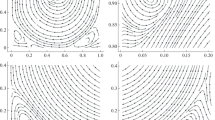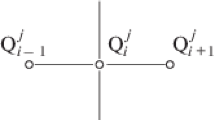Abstract
An original kinetic model for the molecular velocity distribution function is considered. Based on this model, the equations of ideal magnetogasdynamics (MGD) are derived and an original model for dissipative MGD is obtained. The latter model can be used to construct algorithms easily adaptable to high-performance computer architectures. As an example, results of high-performance computations of astrophysical phenomena are presented, namely, the formation of cosmic jets is modeled.
Similar content being viewed by others
References
B. N. Chetverushkin, “Kinetic models for solving continuum mechanics problems on supercomputers,” Math. Models Comput. Simul. 7 (6), 531–539 (2015).
B. N. Chetverushkin, Kinetic Schemes and Quasi-Gas Dynamic System of Equations (MAKS, Moscow, 2004; CIMNE, Barcelona, 2008).
N. D’Ascenzo, V. I. Saveliev, and B. N. Chetverushkin, “On an algorithm for solving parabolic and elliptic equations,” Comput. Math. Math. Phys. 55 (8), 1290–1297 (2015).
B. N. Chetverushkin, N. D’Ascenzo, A. V. Saveliev, and V. I. Saveliev, “Simulation of astrophysical phenomena on the basis of high-performance computations,” Dokl. Math. 95 (1), 68–71 (2017).
M. N. Kogan, Rarefied Gas Dynamics (Nauka, Moscow, 1967; Plenum, New York, 1969)
L. Boltzmann, Lectures on Gas Theory (Dover, New York, 1995).
L. D. Landau and E. M. Lifshitz, The Classical Theory of Fields (Nauka, Moscow, 1988; Butterworth-Heinemann, Oxford, 2000).
B. Chetverushkin, N. D’Ascenzo, S. Ishanov, and V. Saveliev, “Hyperbolic type explicit kinetic scheme of magneto gas dynamics for high performance computing systems,” Russ. J. Numer. Anal. Math. Model. 30 (1), 27–36 (2015).
B. N. Chetverushkin and V. I. Saveliev, Preprint No. 79, IPM RAN (Keldysh Inst. of Applied Mathematics, Russian Academy of Sciences, Moscow, 2015).
P. J. Dellar, “Lattice kinetic schemes for magnetohydrodynamics,” J. Comput. Phys. 179 (1), 95 (2002).
K. Xu and X. He, “Lattice Boltzmann method and gas-kinetic BGK scheme in the low-mach number viscous flow simulations,” J. Comput. Phys. 190 (1), 100 (2003).
J.-P. Croisille, R. Khanfir, and G. Chanteur, “Numerical simulation of the MHD equations by kinetic-type method,” J. Sci. Comput. 10 (1), 81 (1995).
A. A. Zlotnik and B. N. Chetverushkin, “Parabolicity of the quasi-gasdynamic system of equations, its hyperbolic second-order modification, and the stability of small perturbations for them,” Comput. Math. Math. Phys. 48 (3), 420–446 (2008).
B. N. Chetverushkin, N. D’Ascenzo, A. V. Saveliev, and V. I. Saveliev, “A kinetic model for magnetogasdynamics,” Math. Models Comput. Simul. 9 (5), 544–553 (2017).
B. N. Chetverushkin, “Hyperbolic system in magnetogasdynamics,” Mat. Model. (2018) (in press).
B. N. Chetverushkin and A. V. Gulin, “Explicit schemes and numerical simulation using ultrahigh-performance computer systems,” Dokl. Math. 86 (2), 681–683 (2012).
A. A. Samarskii, The Theory of Difference Schemes (Nauka, Moscow, 1976; Marcel Dekker, New York, 2001).
A. G. Kulikovskii, N. V. Pogorelov, and A. Yu. Semenov, Mathematical Aspects of Numerical Solution of Hyperbolic Systems (Chapman and Hall/CRC, London, 2001; Fizmatlit, Moscow, 2012).
D. V. Bisikalo, A. G. Zhilkin, and A. A. Boyarchuk, Gas Dynamics of Close Binary Stars (Fizmatlit, Moscow, 2013) [in Russian].
V. E. Fortov, Physics of High Energy Densities (Fizmatlit, Moscow, 2012) [in Russian].
Ya. B. Zel’dovich, S. I. Blinnikov, and N. I. Shakura, Physical Principles of the Structure and Evolution of Stars (Mosk. Gos. Univ., Moscow, 1981) [in Russian].
M. A. Abramowicz, G. Björnsson, and J. E. Pringle, Theory of Black Hole Accretion Discs (Cambridge Univ. Press, Cambridge, 1999).
Author information
Authors and Affiliations
Corresponding author
Additional information
Original Russian Text © B.N. Chetverushkin, N. D’Ascenzo, A.V. Saveliev, V.I. Saveliev, 2018, published in Zhurnal Vychislitel’noi Matematiki i Matematicheskoi Fiziki, 2018, Vol. 58, No. 5, pp. 716–725.
Rights and permissions
About this article
Cite this article
Chetverushkin, B.N., D’Ascenzo, N., Saveliev, A.V. et al. Kinetic Model and Magnetogasdynamics Equations. Comput. Math. and Math. Phys. 58, 691–699 (2018). https://doi.org/10.1134/S0965542518050068
Received:
Published:
Issue Date:
DOI: https://doi.org/10.1134/S0965542518050068




